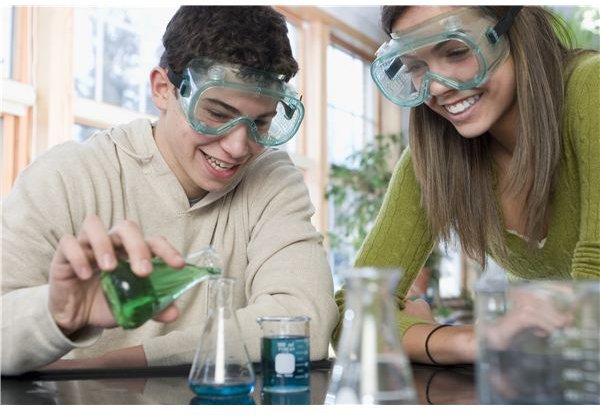Lesson Plan: Chemistry Webquest for Mixture Separation in an Oil Refinery
Getting Started
In this webquest you will be looking at the how, what, when, why and where of oil refining. The How Stuff Works Website has an
abundance of information that you will cull through. Go to the website, read through the information, and answer these questions:
- List at least 4 items that are produced by petroleum. (gasoline, crayons, plastics, heating oil, jet fuel, kerosene, synthetic fibers, tires)
- Watch the Why? Tell Me Why! video about Alaska’s abundance of oil. In your own words, explain why Alaska is so oil-rich. (Two-hundred plus million years ago, conditions in Prudhoe Bay were conducive to crustaceans and microscopic organisms growing and dying in a shallow sea. They were buried quickly and heated, but not too much. The end result was petroleum.)
Crude Oil
Now go back to the How Stuff Works page you accessed above.
3. What is crude oil? (Crude oil is natural petroleum, the raw ingredient straight from the ground.)
4. What are hydrocarbons? (Molecules comprised of hydrogen and carbon atoms are hydrocarbons.)
5. Why are hydrocarbons exciting to chemists? (Hydrocarbons are rich in energy and come in a wide variety of forms.)
From Crude Oil
6. What is the problem with crude oil? (The problem is that it is impure. Scientists need to separate the many different types of hydrocarbons.)
7. What is oil refining all about? (Separating the mixture of hydrocarbons into its components, or fractions.)
8. Describe what happened in an oil refinery. (Heavier hydrocarbons boil at higher temperatures. Chemists use this principle to separate the hydrocarbons from each other. As a mixture is heated, the lightest hydrocarbons boil off first. They are collected. They have been separated from the mixture. This process is repeated until the whole mixture has been sorted.)
9. List the 8 products that come from crude oil and their boiling points.
Answer:
• Petroleum gas, less than 104 F
• Naptha, 140 to 212 F
• Gasoline, 104 to 401 F
• Kerosine, 350 to 616 F
• Diesel, 482 to 662 F
• Lubricating Oil, 572 to 700 F
• Fuel Oil, 700 to 1112 F
• Asphalt & Tar, greater than 1112 F
10. What is the most common way to separate petroleum into various components? (The most common process is to use the different boiling temperatures of liquids to separate them.)
11. Watch the video: Energy Policy: Foreign Oil Sources. Who is the fastest growing user of oil? (China)
Fractional Distillation
Step 1: ________ the mixture with ______________ boiling points. (Heat, different)
Step 2: The mixture ______________, forming gases. (boils)
Step 3: The ____________ enters the bottom of a long column filled with ___________ or ___________. (vapor, trays, plates.)
What are the holes in the trays for?
What do the trays help collect?
Where is it hot in the column? ____ Where is it cold?____
Step 4: The vapor _____________ in the column (rises)
Step 5: What happens to the vapor as it rises? (It cools)
Step 6: (a) When does vapor condense? (when it reaches the height where the boiling point of the liquid is equal to the temperature inside of the column)
(b) What does condense mean? (gas vapor changes into a liquid)
(c) Where do substances with the highest boiling point condense? (lower in the column)
Step 7: What do the trays collect? (the different liquid fractions of the mixture)
Step 8: What happens to the liquid fractions? (they may be cooled even more and then put into storage tanks, or they could be processed further.)
12. Watch the animated diagram: The crude oil flows into the ________ (boiler) where it is heated until it vaporizes. It is then sent to the _________ _________ (distillation column) where it is heated until it vaporizes. The residual is the first to condense with ______(80)carbons (the heaviest molecules condense first.) The last to condense is _____ (gas) with only ___ (4) carbons.
13. How do oil companies make enough gasoline without continuously distilling large amounts of crude oil? (they use chemical processes to turn some of the other fractions into gasoline.)
Chemical Processing, Treating & Blending
To answer these questions, click here to read about Chemical Processing.
14. What does cracking do? How about unification? Alteration?
(Cracking is taking larger hydrocarbons and breaking them up. Unification is combining smaller hydrocarbon pieces together, and alteration is rearranging the connectivity of hydrocarbons to make the wanted product.)
15. To answer this question, go to this page on treating and blending. Why are fractions treated? (Treatments are done to remove the impurities from the fractions.)
16. What is blending? (Blending is taking two or more fractions and mixing them together to make new products, like jet fules or kerosene.)
